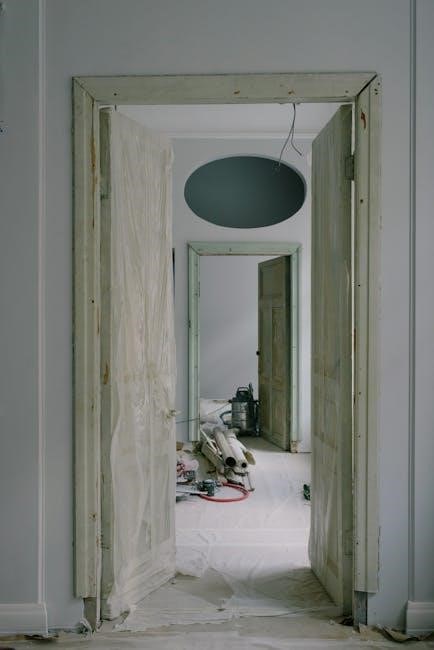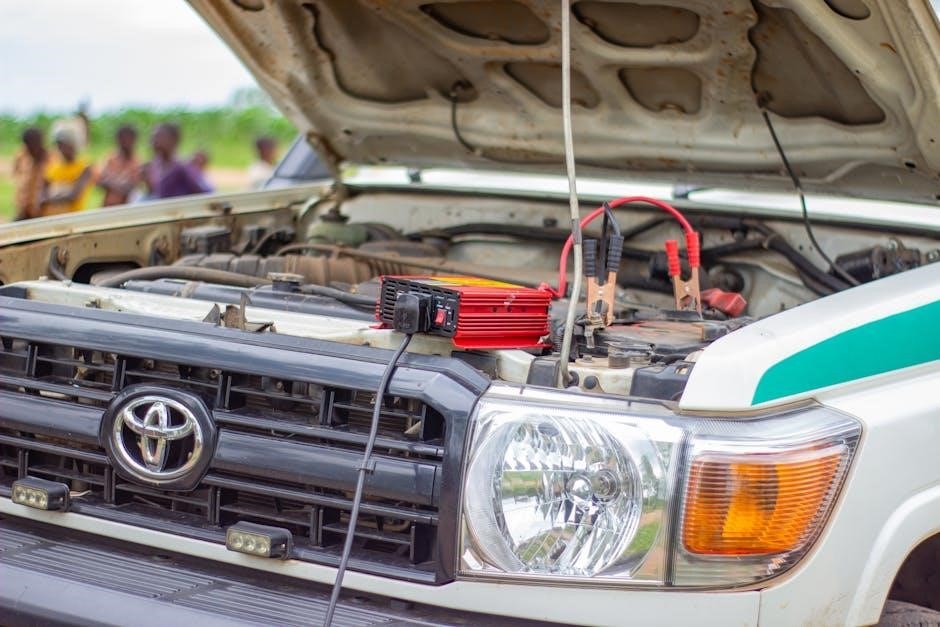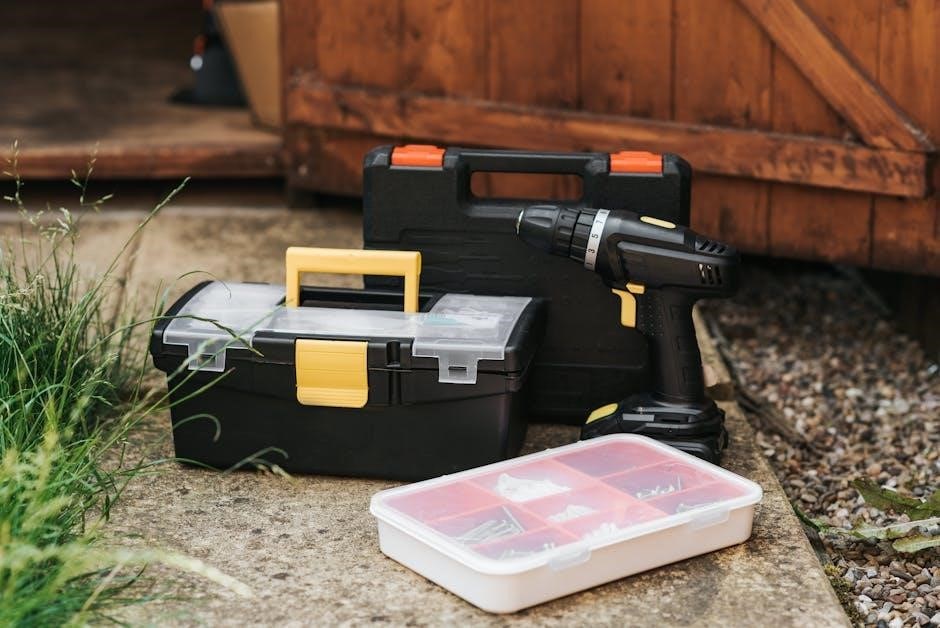A garage door that won’t open manually can be frustrating and inconvenient, often stemming from issues like faulty springs, misaligned tracks, or obstructions in its path.
Understanding the Issue
A garage door that won’t open manually can stem from various issues, such as damaged torsion springs, misaligned tracks, or obstructions blocking the door’s path. It’s crucial to identify the root cause to avoid further damage or safety risks. Simple problems like a locked door or debris interference can often be resolved quickly, while more complex issues, such as broken springs or opener malfunctions, may require professional attention. Understanding the underlying problem ensures effective troubleshooting and prevents potential hazards, like springs under high tension causing injury. Early identification also helps avoid escalating the issue into more costly repairs. Always approach the problem methodically to ensure safety and efficiency.
Importance of Immediate Action
Importance of Immediate Action
Addressing a garage door that won’t open manually is crucial to prevent further damage and ensure safety. Delaying action can lead to more severe issues, such as additional wear on components or potential accidents. If torsion springs are damaged, they can snap, causing injuries or costly repairs. Similarly, ignoring misaligned tracks or obstructions may result in the door becoming more difficult to repair over time. Immediate action also restores access to your garage, minimizing inconvenience, especially if your vehicle or essential items are trapped inside. Prompt troubleshooting and repairs help maintain the door’s functionality and longevity, ensuring it operates smoothly and safely. Acting quickly is essential to avoid escalating problems and potential hazards.
Common Causes of a Garage Door That Won’t Open Manually
Common causes include broken torsion springs, misaligned tracks, obstructions, and a malfunctioning opener. Addressing these issues promptly is essential for proper function and safety.
Locked Door
A locked garage door is a common reason it won’t open manually. If the lock is engaged, the door remains secure, preventing manual operation. To resolve this, locate the lock mechanism, typically found on the door or track, and disengage it. Use the key or manual release if necessary. Ensure the lock is fully disengaged before attempting to open the door. Forgetting to unlock can lead to damage, so always check this first. If the door is unlocked but still won’t open, other issues like misaligned tracks or broken springs may be the cause. Regularly inspect and maintain the locking mechanism to ensure smooth operation.

Broken or Damaged Torsion Springs
Broken or damaged torsion springs are a primary cause of a garage door failing to open manually. These springs are under immense tension and can snap due to wear, overuse, or poor maintenance. When a spring breaks, the door becomes unbalanced, making it impossible to lift manually. Attempting to force the door open can lead to further damage or injury. Inspecting the springs for visible signs of damage, such as gaps or sagging, is crucial. If a spring is broken, it’s essential to replace it promptly, as the door’s operation depends on its integrity. Always use caution, as torsion springs can cause serious harm if mishandled. Regular inspections and maintenance can help prevent such issues.
Misaligned or Warped Tracks
Misaligned or Warped Tracks
Misaligned or warped tracks are a common reason why a garage door won’t open manually. The tracks guide the door’s movement, and if they are bent, dented, or out of alignment, the door can’t slide smoothly. This issue often occurs due to accidental bumps, heavy impacts, or even subtle shifts in the garage’s foundation over time. Warped tracks can cause the door to catch or jam, making manual operation impossible. Inspecting the tracks for visible damage or misalignment is crucial. If the tracks are slightly bent, they may be straightened with tools, but severely warped tracks require replacement. Proper alignment ensures smooth door movement and prevents further complications. Regular checks can help identify such issues early.

Obstructions in the Door’s Path
Obstructions in the door’s path are a primary cause of manual opening issues. If objects like tools, boxes, or debris block the doorway, the door cannot move freely. Even small items, such as toys or loose items on the floor, can prevent the door from opening smoothly. When attempting to open the door manually, these obstructions create resistance, causing the door to stop or jam. Additionally, if the door is automated, its safety sensors may detect blockages and prevent operation. Clearing the area around the door and ensuring the path is unobstructed is essential for proper function. Regularly inspecting the doorway for potential hindrances can help avoid this issue and ensure smooth manual operation. Addressing this problem promptly prevents further complications.
Malfunctioning Garage Door Opener
A malfunctioning garage door opener can prevent the door from opening manually. Issues like stripped gears, a broken motor, or a faulty drive system within the opener can cause this problem. If the opener’s internal mechanisms are damaged, it may lock the door in place, making manual operation difficult. Additionally, if the opener’s sensors or safety features are malfunctioning, they might incorrectly signal that an obstruction is present, halting the door’s movement. In such cases, disconnecting the opener or engaging the manual override can help bypass the issue temporarily. However, addressing the root cause by inspecting and repairing or replacing the opener is essential for long-term resolution. Professional assistance may be required for complex repairs.

Troubleshooting Steps
Begin by checking the door’s lock status and ensuring it’s fully disengaged; Inspect torsion springs for damage and clear any obstructions in the door’s path.
Checking the Door’s Lock Status
Start by ensuring the garage door is not locked, as this is a common reason it won’t open manually. Many garage doors have a manual lock feature, often located near the bottom section. If the lock is engaged, the door will not budge, even if you try to lift it. To check, look for a metal latch or locking mechanism and verify it is fully disengaged. If the door has an interior lock, it may require a key to unlock or a secondary release mechanism. Always ensure all locks are fully open before attempting to manually operate the door. This simple step can save time and effort in troubleshooting.
Inspecting Torsion Springs for Damage
Torsion springs are a critical component of your garage door system, and their failure can prevent the door from opening manually. Begin by visually inspecting the springs located above the door for any signs of damage, such as cracks, gaps, or a disconnected coil. If a spring is broken or stretched, the door will not function properly. Due to the high tension stored in these springs, never attempt to touch or repair them yourself, as this can lead to serious injury. If you notice any damage, contact a professional to replace the springs. Regular inspection can help identify potential issues before they cause the door to malfunction.
Clearing Obstructions
One common reason a garage door won’t open manually is the presence of obstructions in its path. Begin by thoroughly inspecting the door’s tracks and surrounding areas for any objects that may be blocking movement, such as boxes, tools, or debris. Gently remove any items that are interfering with the door’s operation. Additionally, check for dirt, leaves, or grease buildup on the tracks, as these can hinder smooth movement. Use a broom or vacuum to clean the tracks and ensure they are free from obstructions. Once cleared, manually test the door to ensure it opens and closes smoothly. Addressing these issues promptly can resolve the problem without further complications.
Testing the Garage Door Opener
Testing the garage door opener is crucial when diagnosing why the door won’t open manually. First, ensure the opener is properly plugged in and the circuit breaker hasn’t tripped. Replace remote control or keypad batteries and test functionality. If the door doesn’t respond, check for issues like misaligned sensors or faulty wiring. Some openers have a manual override feature—consult the manual to engage this. Additionally, inspect the opener’s gears and drive system for wear or damage, as these can prevent the door from moving. If the opener’s motor runs but the door doesn’t budge, it may indicate stripped gears or a broken chain. In such cases, professional assistance is recommended to avoid further damage.

Solutions and Repairs
Replace broken torsion springs, align tracks properly, and repair or replace the garage door opener if malfunctioning. Ensure all components are securely fastened for smooth operation.
Replacing Broken Torsion Springs
Replacing broken torsion springs is a critical repair for a garage door that won’t open manually. Torsion springs are under high tension and can cause serious injury if they break. To replace them, first, inspect the springs to confirm damage. Wear protective gear, including gloves and safety glasses, to minimize risks. Purchase a replacement spring kit that matches the door’s specifications. Disconnect the garage door opener and carefully unwind the broken spring using the provided tools. Install the new spring, ensuring it is properly aligned and securely fastened. After installation, test the door’s balance by lifting it manually. If the door feels heavy or uneven, adjust the spring tension as needed. If unsure, consider hiring a professional to avoid accidents and ensure proper functionality.
Aligning the Tracks Properly
Aligning the tracks properly is essential for smooth garage door operation. Start by inspecting the tracks for any visible damage or obstructions. Use a carpenter’s level to ensure the tracks are perfectly aligned and parallel to each other. If misaligned, loosen the bolts holding the tracks in place and gently adjust them into the correct position. Tighten the bolts securely once aligned. Check the tracks for proper leveling, as uneven tracks can prevent the door from opening manually. Clear any debris or obstructions that may interfere with the door’s movement. After aligning, manually test the door to ensure it glides smoothly along the tracks. Regular track inspections and adjustments can prevent future issues.
Fixing or Replacing the Garage Door Opener
Fixing or replacing the garage door opener may be necessary if it’s malfunctioning. First, check the opener’s power supply and ensure it’s plugged in. Replace remote or keypad batteries if they’re dead. If the issue persists, inspect the opener’s gears and drive system for wear or damage. Lubricate moving parts to ensure smooth operation. If the motor is faulty or the opener is outdated, consider replacing it with a new model. Ensure the new opener is compatible with your door’s weight and type. Follow the manufacturer’s instructions for installation. After installation, test the opener to ensure it operates smoothly and synchronizes with the door’s movement. Regular maintenance can prevent future opener malfunctions and ensure reliable performance.

Preventive Maintenance Tips
Regularly inspect and lubricate garage door components like springs, rollers, and tracks to ensure smooth operation and prevent manual opening issues. Schedule annual professional inspections. Avoid forcing the door open, as this can cause further damage. Ensure the door is properly aligned and balanced to reduce strain on the opener. Clean tracks and rollers to remove dirt and debris that may obstruct movement. Replace worn-out parts promptly to maintain functionality. By following these tips, you can extend the lifespan of your garage door and avoid unexpected malfunctions. Consistent upkeep helps prevent common issues and ensures reliable performance over time. This proactive approach saves time and money by addressing potential problems before they escalate.
Periodic Inspection of Springs and Tracks
Regularly inspecting the torsion springs and tracks is crucial for maintaining smooth garage door operation. Check the springs for visible signs of damage, rust, or wear, as these can lead to manual opening issues. Ensure the tracks are aligned properly and free from obstructions or debris. Lubricate moving parts annually to reduce friction and prevent corrosion. If you notice any damage or misalignment, address it promptly to avoid further complications. Neglecting these inspections can result in costly repairs or safety hazards. Schedule professional checks at least once a year to ensure everything is in optimal condition. This proactive approach helps prevent unexpected malfunctions and keeps your garage door functioning reliably. Consistent upkeep is key to avoiding manual operation problems and ensuring long-term durability.